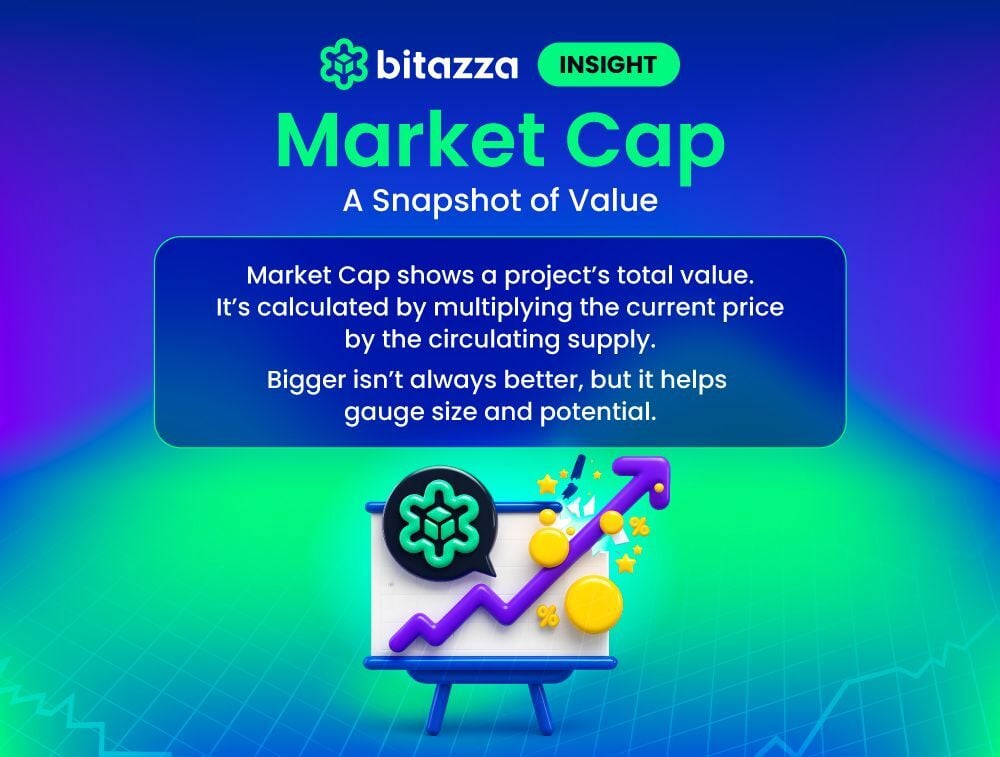Share this
What is Market Cap, and Why Does It Matter in Crypto?

When browsing crypto markets, you’ve probably come across the term Market Cap next to every token. But what does it actually mean, and why should you care?
Let’s break it down.
What Is Market Cap?
Market Cap (short for Market Capitalization) is the total value of a cryptocurrency currently in circulation.
It’s calculated using a simple formula:
Market Cap = Current Price × Circulating Supply
For example:
If a token is priced at $2 and there are 1 billion tokens in circulation, the market cap is $2 billion.
It gives you a quick way to measure the overall size and weight of a crypto project in the market.
Why Does Market Cap Matter?
Think of market cap as a crypto size signal. It helps you understand where a token stands relative to others.
Here’s why it’s useful:
- Size and Liquidity: A larger market cap often signals more adoption, more liquidity, and usually more stability.
- Risk Indicator: Lower market cap tokens can offer high growth potential, but they’re often more volatile and riskier.
- Portfolio Strategy: Market cap helps traders and investors balance between large-cap (BTC, ETH), mid-cap (LINK, MATIC), and small-cap assets (newer or niche tokens).
Common Misconceptions
Don’t let the number fool you. Market cap isn’t everything.
- It doesn’t mean “value.” A high market cap simply means a lot of money is currently invested in the token. It doesn’t necessarily reflect the quality or utility of the project.
- It’s not a forecast. Market cap only shows where a token stands today. It doesn’t predict future performance.
- It doesn’t always reflect total supply. Market cap usually uses circulating supply. Some platforms also show fully diluted valuation (FDV), which is based on the maximum possible supply of a token. This can help you understand long-term supply dynamics and potential price behavior.
How Can You Use Market Cap in Your Research?
While Bitazza may not display market cap directly for every token in the app, you can still use it as part of your research toolkit.
Here’s how:
- Check it externally on trusted platforms like CoinGecko or CoinMarketCap.
- Cross-reference that with Bitazza’s token info, including price, trading volume, and recent trends.
- Compare similar projects using market cap to understand differences in adoption, liquidity, or popularity.
- Use it for context. A token with a small cap but rising volume might signal early momentum or market interest.
Pro tip: Always dig deeper. Some tokens may have locked or reserved supplies that don’t count toward circulating supply, which can skew your perception of scarcity and price potential.
Summary
Market Cap gives you a fast snapshot of a token’s total value in the market. It’s a useful comparison tool and can help guide decisions around risk and asset allocation.
But it’s only one piece of the puzzle. Combine it with other indicators like trading volume, token supply, and utility to make smarter moves. Explore and trade 100+ tokens on Bitazza.
Want to learn more about smart crypto strategies? Check out our blog.
Share this
- Crypto 101 (75)
- Trading (59)
- Crypto Weekly (43)
- Educational (43)
- Bitazza 101 (41)
- Featured (10)
- Missions (8)
- Market (6)
- Bitazza Insight (5)
- Research (5)
- TradingView (4)
- Derivatives (3)
- Education (3)
- Futures Trading (3)
- Freedom Shards (1)
- Freedom Token (FDM) (1)
- Intermediate (1)
- Product and features (1)
- Tether (1)
- Tether (USDt) (1)
- crypto exchange (1)
- November 2025 (4)
- October 2025 (10)
- September 2025 (8)
- August 2025 (17)
- July 2025 (29)
- June 2025 (13)
- May 2025 (14)
- April 2025 (12)
- March 2025 (8)
- February 2025 (8)
- January 2025 (8)
- December 2024 (7)
- November 2024 (5)
- October 2024 (14)
- September 2024 (9)
- August 2024 (14)
- July 2024 (3)
- June 2024 (48)
No Comments Yet
Let us know what you think